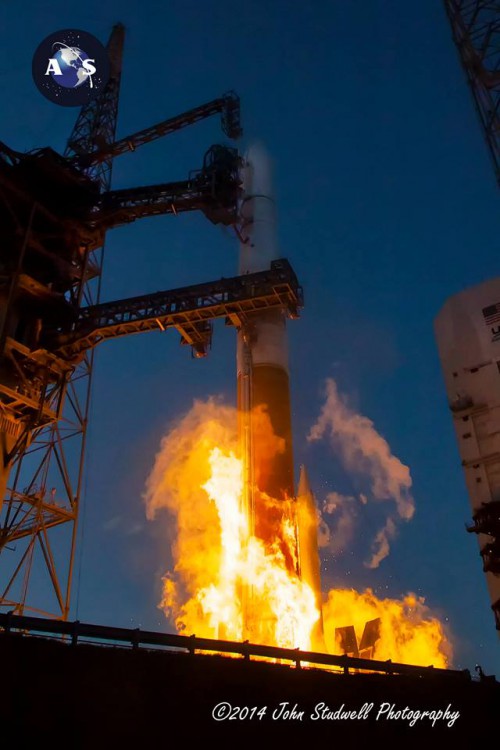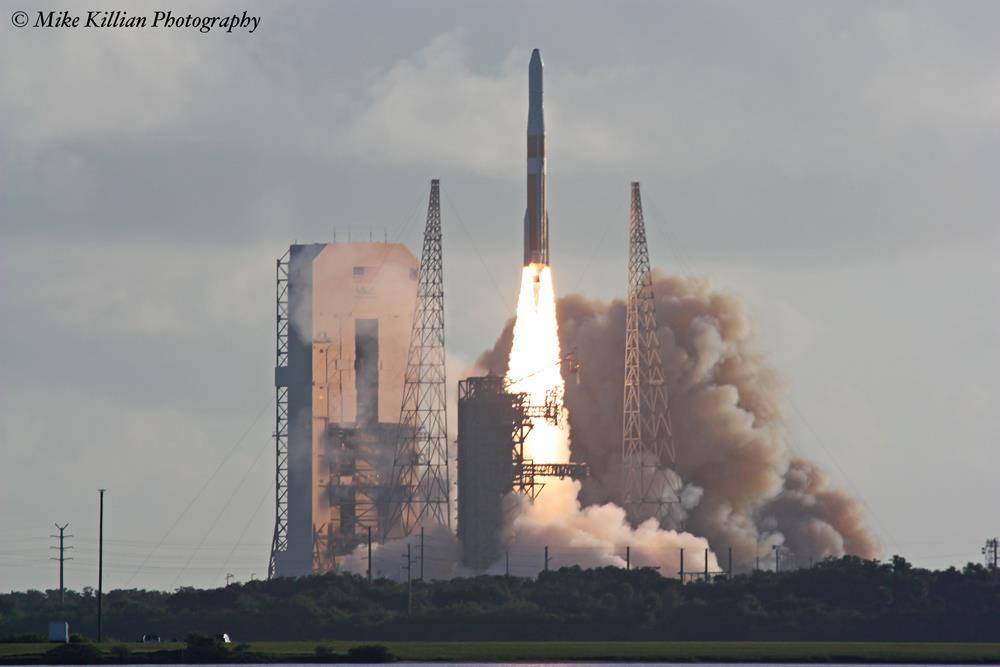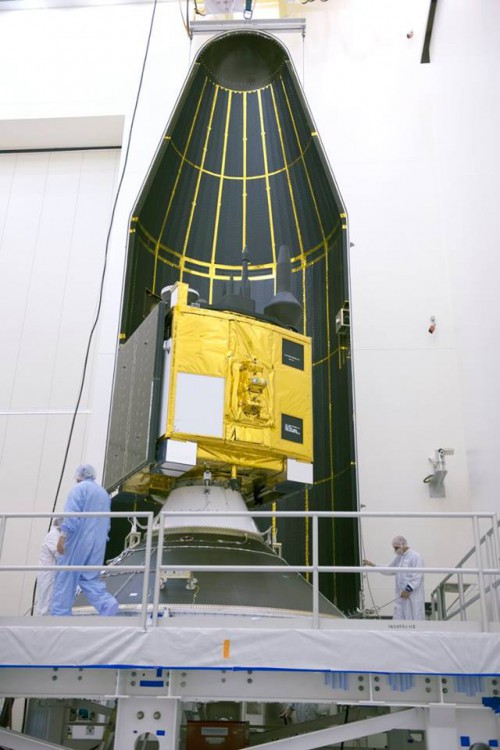
After three successful flights in as many months—the Mobile User Objective System (MUOS)-3 and Soil Moisture Active Passive (SMAP) satellites, both in January, and most recently the Magnetospheric Multiscale Mission (MMS), two weeks ago—United Launch Alliance (ULA) is primed to deliver the next member of the Global Positioning System (GPS) Block IIF constellation into a Medium Earth Orbit (MEO), at an altitude of 11,047 nautical miles (20,460 km). Liftoff of the Delta IV Medium+ (4,2) booster, carrying GPS IIF-9, is slated to occur at 2:36 p.m. EDT on Wednesday, 25 March, from Space Launch Complex (SLC)-37 at Cape Canaveral Air Force Station, Fla., at the opening of an 18-minute “window.” If ULA is forced to scrub Wednesday’s attempt, it has Eastern Range clearance for a backup opportunity on Thursday, 26 March, whose 18-minute window opens four minutes earlier, at 2:32 p.m. The mission will mark the latest effort by ULA to complete the 12-strong Block IIF network of global positioning, velocity, and timing satellites by 2016.
The Delta IV Medium+ (4,2) is numerically designated to identify a 13-foot-diameter (4-meter) Payload Attach Fitting (PAF) and the presence of two solid-fueled Graphite Epoxy Motors (GEM)-60. It was utilized for the maiden voyage of the Delta IV, way back in November 2002, which launched the commercial Eutelsat W5 communications satellite into Geostationary Transfer Orbit (GTO). Since the formation of ULA as a merger between Boeing and Lockheed Martin in December 2006, the variant has been one of the Centennial, Colo.-based launch services company’s most reliable workhorses. As a rocket, it can loft payloads up to 26,280 pounds (11,920 kg) into low-Earth Orbit (LEO) and up to 14,800 pounds (6,720 kg) into GTO.

Since its maiden voyage, the Medium+ (4,2) has boosted the classified NROL-22 and NROL-27 reconnaissance satellites in June 2006 and March 2011 respectively, on behalf of the National Reconnaissance Office, as well as a pair of Geostationary Operational Environmental Satellites (GOES) for meteorological research in June 2009 and March 2010. More recently, between May 2010 and May 2014, it placed five members of the current eight-strong GPS Block IIF network into MEO. (The others have been delivered to orbit by ULA’s Atlas V, most recently the GPS IIF-8 satellite in October 2014.)
In spite of an upper-stage thrust shortfall during the GPS IIF-3 ascent in October 2012, the Medium+ (4,2) has never failed to deliver a primary payload into orbit. Wednesday’s flight will be the 13th mission by a Medium+ (4,2), as well as the 29th overall by a Delta IV and the 95th overall voyage by a member of ULA’s fleet of boosters, which also includes the Atlas V and Delta II.
The central element of the Medium+ (4,2) is a single Common Booster Core (CBC), fabricated in Decatur, Ala., which arrived at SLC-37B for processing in late January. It stands 134 feet (41 meters) tall and is equipped with a single RS-68 engine, developed by Aerojet Rocketdyne. Fueled with cryogenic oxygen and hydrogen, the RS-68 generates 663,000 pounds (300,000 kg) of propulsive yield at the instant of liftoff. It will roar to life at T-5 seconds and undergo a brief period of computer-controlled health checks, ahead of the command to fire the twin GEM-60 strap-on boosters—each of which delivers 191,400 pounds (86,820 kg) of thrust—at T-0.01 seconds and the release of the hold-down clamps to permit launch and climb-out at T-0.
Preparations for the mission will enter high gear in the small hours of Wednesday morning, when the Mobile Service Tower (MST) will commence its 25-minute rollback to expose the Delta IV Medium+ (4,2) to the elements. According to the 45th Space Wing at Patrick Air Force Base, current predictions carry a 80 percent likelihood of acceptable weather conditions, although this is expected to decline to 70 percent favorable in the event of a scrub and 24-hour turnaround to Thursday. Key violating factors are Flight Through Precipitation and Cumulus Clouds.
“A weak front will move into the area Monday, bringing showers and just a slight chance of a thunderstorm,” noted the 45th in its Sunday morning status report. “The front will move off to the east Tuesday and high pressure will build in to the north, improving weather. On launch day, the high-pressure area to the north will move east, causing winds to shift to the south-east and increase through the day. The on-shore wind, along with low-level moisture, will cause isolated morning coastal showers, but showers will decrease by the afternoon launch window.” In the event of a scrub on Wednesday, ULA has Eastern Range clearance for a backup launch attempt on Thursday, when “gusty winds … expected in the morning” should shift to the southwest and decrease in ferocity later in the day, but an anticipated deepening of atmospheric moisture will create an elevated likelihood of the development of cumulus cloud cover and precipitation along the afternoon sea breeze.

The final pre-planned hold in Wednesday’s countdown will come at T-4 minutes, and, assuming a satisfactory “Go/No-Go” poll of all engineers, flight controllers, and managers, a definitive “Go for Launch” will be issued and the clock will be released at 2:32 p.m. EDT. In the final minutes, flight plans will be uploaded to the rocket’s on-board navigation computer, the propellant tanks will be secured and the fill-and-drain valves will be closed for flight. The vehicle will be transferred to Internal Power and at T-3 minutes the Flight Termination System (FTS)—tasked with destroying the Delta IV in the event of an accident during ascent—will be armed. With all liquid oxygen and hydrogen propellants confirmed at flight pressures, the Eastern Range will declare its readiness to support the launch at T-60 seconds. At this stage, all tracking stations will report themselves to be on-line, all ground stations will be in receipt of telemetry and all shipping will have been cleared from the danger area.
Following the liftoff command, the vehicle—which stands 206 feet (62 meters) tall, when topped off with its Delta Cryogenic Second Stage (DCSS) and PAF—will be released from SLC-37B and commence a fast climb away from the pad. This will kick off the first Delta IV mission since last December’s Orion flight test and the first voyage by a Medium+ (4,2) since July 2014. Eight seconds into the flight, the booster will execute a combined pitch, yaw, and roll program maneuver to establish itself onto the proper 46.16-degree flight azimuth to inject the GPS IIF-9 payload into MEO. It will burst through the sound barrier at T+48.4 seconds, and, at one minute after launch, it will encounter a period of maximum aerodynamic turbulence on its airframe, known colloquially as “Max Q.” The GEM-60 boosters, each of which measures 53 feet (16.1 meters) in length, will exhaust their solid fuel at T+95 seconds and will be jettisoned at 100 seconds into the mission. This will leave the RS-68 to propel the stack toward orbit for a further three minutes. It will be shut down at T+248.1 seconds and discarded seven seconds later, ahead of the ignition of the DCSS.

Equipped with Aerojet Rocketdyne’s RL-10B2 engine, capable of 24,750 pounds (11,220 kg) of thrust, the second stage will come to life for the first of two “burns” at T+269.6 seconds. Eleven seconds later, the two-piece (or “bisector”) shell of the PAF will be jettisoned. Measuring 38.5 feet (11.7 meters) long, the bullet-like PAF provides GPS IIF-9 with aerodynamic, acoustic, and thermal protection during its ascent through the low atmosphere. Its departure will expose the satellite to the space environment for the first time. The RL-10B2 will shut down at T+930.9 seconds—some 15 minutes and 30.9 seconds after launch from the Cape—and the stack will “coast” for almost three hours.
The second “burn” of the DCSS is scheduled to begin at three hours and two minutes into the flight, and will run for 106 seconds, before shutting down. This will position GPS IIF-9 into a circular orbit at an altitude of 11,047 nautical miles (20,460 km), inclined 55 degrees to the equator. Twelve minutes after the conclusion of the second RL-10B2 burn, the satellite will be released from the upper stage.
Launching GPS IIF-9 follows hard on the heels of 2014’s delivery of four similar satellites—GPS IIF-5 in February, GPS IIF-6 in May, GPS IIF-7 in August, and most recently GPS IIF-8 in October—by ULA, all of which are now fully operational in MEO. The newest arrival will mark three-quarters-complete for the 12-strong “Interim” Block IIF constellation. The forthcoming GPS IIF-10 and GPS IIF-11 satellites are presently targeted for launch in June and September 2015, followed by GPS IIF-12 in 2016, which will form a network to keep the Navstar system fully operational until the next-generation and long-delayed GPS Block IIIA comes online, no sooner than 2017.
From its semi-synchronous MEO position, GPS IIF-8 will circle Earth once every 12 hours. It boasts improved positioning, velocity, and timing accuracy, a reprogrammable processor, an interference-free civilian signal for commercial aviation search and rescue, and a new Military code (or “M-code”) to offer better resistance to electronic jamming. “As each IIF satellite becomes operational, we continue the seamless transformation of the GPS constellation into an even more accurate, reliable, and durable navigation resource for the U.S. military and the global civilian user community,” said Craig Cooning, vice president and general manager of Boeing Space & Intelligence Systems. “Our efficient pulse-line manufacturing process, adapted from Boeing’s commercial airplane production lines, also ensures that we deliver each spacecraft on time and on cost.”
In the meantime, the Air Force expects the next-generation GPS IIIA network to enter service from 2017 onward, about three years later than originally intended, primarily due to ongoing payload problems. It awarded a $1.4 billion contract to Lockheed Martin in May 2008 to develop this new network, which may eventually comprise as many as 32 satellites, although the Air Force has only formally contracted for four of these. With 500 times the transmitter power of current systems, the IIIA satellites will benefit from improved navigational warfare capabilities, enabling them to shut off GPS services to limited geographical locations, whilst maintaining service to U.S. and allied forces. The GPS satellite system is operated and controlled by the 50th Space Wing, located at Schriever Air Force Base, Colo.
Want to keep up-to-date with all things space? Be sure to “Like” AmericaSpace on Facebook and follow us on Twitter: @AmericaSpace
Missions » GPS » Missions » GPS » GPS IIF-9 »



